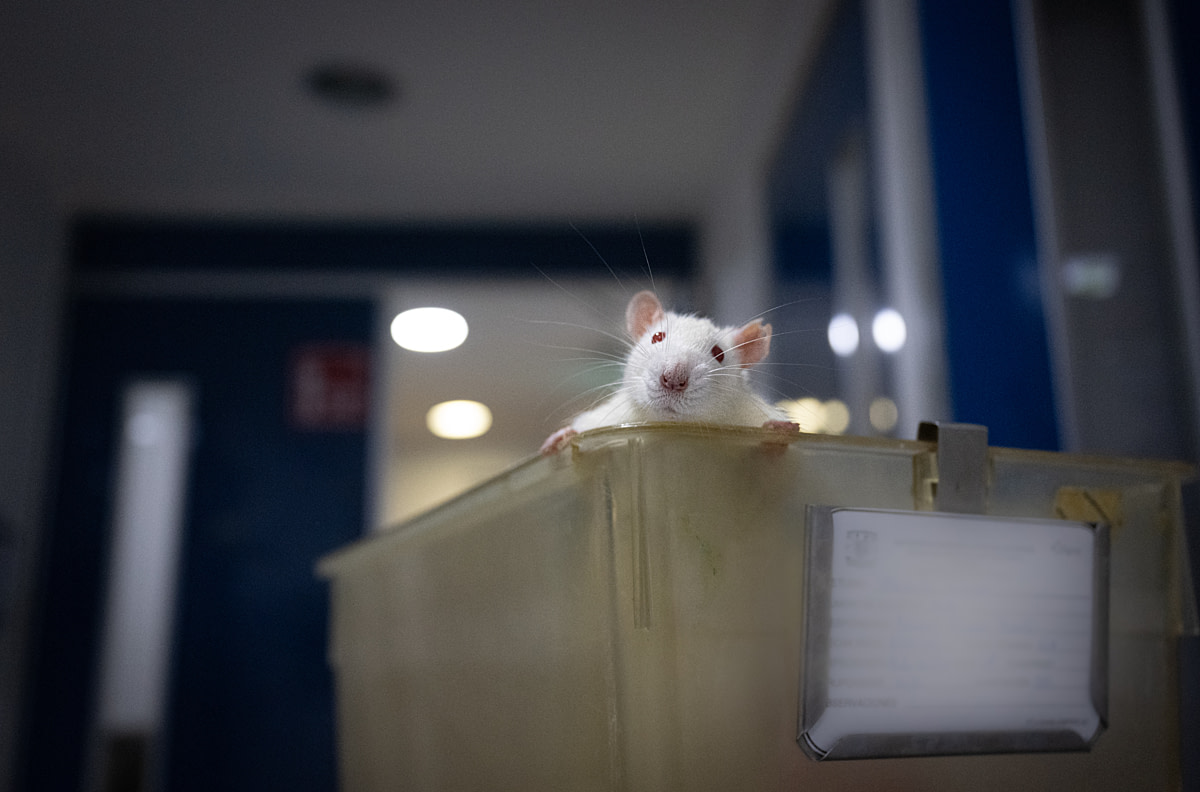Jo-Anne McArthur / Te Protejo / We Animals
Photographer: Jo-Anne McArthur
Some of us have purposely lived with rats and mice. They were first domesticated in the early 17th century, and they continue to be popular pets. I’ve lived with countless rescued rodents, many of whom were allowed to roam around the house when we were home. Not kidding! It was a lot of fun, especially for them. One of my roommates adopted a white rat who was rescued from a laboratory. They named her Chicken. Observing her over months, our thoughts on rat intelligence were confirmed.

A male rat bred for medical research at a breeding facility looks up inquisitively over the edge of the container he lives in. The container lid was removed to facilitate photographing and filming him. Undisclosed location, Mexico, 2025.
The more we know about rodent sentience and intelligence, the more controversial it becomes that we keep millions of them in the deprived environments of biomedical research facilities each year. Ironically, lab studies of rats, like those described in the Harvard Business Review, have shown that they are incredibly intelligent, sometimes even more so than humans.
Rats are trainable. They can know their names, solve puzzles, and navigate mazes. They show empathy and help other animals in distress. When they laugh or are being tickled, those vocalizations register at a sound frequency we can only detect with specialized equipment. And mice? They are great problem-solvers, too. They are fast learners with good memories. They understand body language and facial expressions.

A mother Wistar strain rat lies inside a container where she lives at a biomedical animal breeding facility as her pups nurse and nap. They are among the 7,000 rats and mice who live at the facility. Undisclosed location, Mexico, 2025.

A masked researcher wearing protective clothing explains the ventilation system at a biomedical animal breeding facility housing 7,000 mice and rats. Undisclosed location, Mexico, 2025.
Recently, I went on assignment with Te Protejo, an NGO working to end animal research and testing in Latin America. During the assignment, I was welcomed to the breeding facility of a research lab because its animal welfare standards are world-class. The researcher was proud to show us the significant upgrades in air quality, space, and cleanliness that he had designed and built. He’s also a vocal advocate for New Approach Methodologies (NAMs), which can replace animal testing. I was grateful to get a glimpse of what’s considered modern progress in lab animal housing.

A staff member works inside a room at a biomedical animal breeding facility where animals live in stacks of small plastic containers. This lab houses approximately 7,000 rats and mice. The animals live alone, with breeding partners, or with their young. Undisclosed location, Mexico, 2025.

A Wistar strain rat peers out from their container, one of many stacked at a biomedical animal breeding facility housing 7,000 mice and rats. These rats live alone, with breeding partners, or with their young. Undisclosed location, Mexico, 2025.

A mother Wistar strain rat looks out from her container at a biomedical animal breeding facility while her young pups rest nearby. The facility houses approximately 7,000 rats and mice. Undisclosed location, Mexico, 2025.
When a lid was removed from one of the small containers in which they live, the rats and mice would poke their heads out or climb the side of the plastic container. They would look around and interact with us. I wondered if they still carried an intuition for escape. The rats, especially, were not afraid of eye contact with us. Because of this, I was able to get good photos of them looking at me and into my lens (in photography, someone looking into the lens means they are immortalized, making eye contact with the picture’s audience).

A Wistar strain rat looks out from their cage after the lid is lifted at a biomedical breeding facility housing 7,000 mice and rats. These rats live alone, with breeding partners, or with their young. Undisclosed location, Mexico, 2025.
“Working with We Animals and having real photos of “bioterios” for the first time in Latin America is a milestone for our organization. It allows us to raise awareness of our mission at the local level, showing through images what these animals experience, how they live, and what it means for them to grow up in these facilities, where they will never see sunlight or feel the grass. This registry is key to disseminating our work and thus being able to generate real change for animals used in laboratories.” — Nicole Valdebenito – Co-founder and Advocacy Director, Te Protejo
These animals are so smart. In breeding facilities, they live in conditions antithetical to the natural world. Some of the containers have enrichment, like a tiny tube to move through or a plastic ball to push around. This is where they spend their lives before being used for experimentation. Or they are euthanized without being used at all because they have reached a certain age and are replaced with younger rodents.
Given what we know about rat and mouse sentience and intelligence, we need more public outcry, more boycotts of products tested on lab animals, and more pressure and support to move rapidly toward new methodologies and non-animal models.









A mouse climbs up the side of a clear container at a biomedical breeding lab housing 7,000 mice and rats. Several strains of mice are bred in the lab including the C57BL/6. The animals live alone in the containers, with breeding partners, or with their young. Undisclosed location, Mexico, 2025.
“At Te Protejo, we work towards transforming Latin America’s cosmetic industry to end the use of animals and spread awareness about animals used for research. We see transparency and knowledge as powerful tools for change, which is why we created the #MásQueUnNúmero (More Than A Number) campaign. Rats and mice are among the most used animals in experiments and have long been hidden from view, so with this campaign, we aim to make rats and mice visible beyond the lab and raise awareness of their intelligence, emotions, and social nature.” — Daniela Medina – Co-founder and Research Director, Te Protejo
We’re thrilled that Te Protejo is making these stories visible across Chile with billboards that call attention to the lives behind the research.
Learn more about Te Protejo’s campaign, #MásQueUnNúmero.







Photos courtesy of Te Protejo. Chile, 2025.
World Day for Laboratory Animals (WDLA), also known as World Day For Animals In Laboratories (WDAIL), is observed annually on April 24 to commemorate the hundreds of millions of hidden animals who have suffered – and continue to suffer – in the name of research.
Photographer: Jo-Anne McArthur
Help share the stories of animals used for research. Explore and download these visuals and more via the We Animals Stock Site.


